New Releases for November 2019 - The Armies and Enemies of Ancient Greece & Macedonia
THE ANCIENTS COLLECTION
ARMIES AND ENEMIES OF ANCIENT GREECE AND MACEDONIA
THE PELOPONNESIAN WAR (431-404BC)
THE SPARTAN ARMY
The Peloponnesian War (431–404 BC) was an ancient Greek war fought by the Delian League led by Athens against the Peloponnesian League led by Sparta. Historians have traditionally divided the war into three phases. In the first phase, the Archidamian War, Sparta launched repeated invasions of Attica, while Athens took advantage of its naval supremacy to raid the coast of the Peloponnese and attempt to suppress signs of unrest in its empire. This period of the war was concluded in 421 BC, with the signing of the Peace of Nicias. That treaty, however, was soon undermined by renewed fighting in the Peloponnese. In 415 BC, Athens dispatched a massive expeditionary force to attack Syracuse, Sicily; the attack failed disastrously, with the destruction of the entire force in 413 BC. This ushered in the final phase of the war, generally referred to either as the Decelean War, or the Ionian War. In this phase, Sparta, now receiving support from the Achaemenid Empire, supported rebellions in Athens's subject states in the Aegean Sea and Ionia, undermining Athens's empire, and, eventually, depriving the city of naval supremacy. The destruction of Athens's fleet in the Battle of Aegospotami effectively ended the war, and Athens surrendered in the following year. Corinth and Thebes demanded that Athens should be destroyed and all its citizens should be enslaved, but Sparta refused.
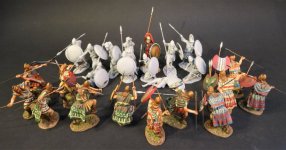
The Peloponnesian War reshaped the ancient Greek world. On the level of international relations, Athens, the strongest city-state in Greece prior to the war's beginning, was reduced to a state of near-complete subjection, while Sparta became established as the leading power of Greece. The economic costs of the war were felt all across Greece; poverty became widespread in the Peloponnese, while Athens found itself completely devastated, and never regained its pre-war prosperity.
Ancient Greek warfare, meanwhile, originally a limited and formalized form of conflict, was transformed into an all-out struggle between city-states, complete with atrocities on a large scale. Shattering religious and cultural taboos, devastating vast swathes of countryside, and destroying whole cities, the Peloponnesian War marked the dramatic end to the fifth century BC and the golden age of Greece.
The city of Sparta was just one of the cities located in the ancient Greek state called Lakedaimon. Most of the other cities of Lakedaimon by this time had become subjects of Sparta.
Around the middle of the 5th Century BC the Lakedaimonians started to lighten the equipment of their holpites. The traditional greaves and cuirass were discarded, and the closed Corinthian helmet was replaced by the open-faced “Pilos Helmet”.
A crimson short sleeved tunic, the “exomis” was commonly worn, with the right shoulder unpinned and allowed to fall leaving the right arm and shoulder free for action. In the 4th Century the army of Agesilaos was clad entirely in Crimson. This had become the colour of the soldier and especially of the Lakedaimonian soldier. Apparently the Lakedaimonian soldier was even buried in his crimson robe.
During this period the Lakedaimonians were allowed to grow their hair and beard when on campaign, a style which had fallen out of fashion elsewhere in Greece at this time.
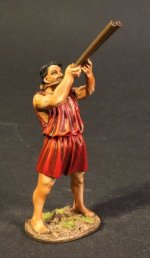
SPT-02
ARMIES AND ENEMIES OF ANCIENT GREECE
AND MACEDONIA,
THE PELOPONNESIAN WAR 431-404BC,
THE SPARTAN ARMY,
SPARTAN PIPER.
(1 pc)
Sparta was pretty much like every other Greek state. They had music, art and poetry. During the seventh century, a musician named Terpander came to Sparta and established himself there. He is called the “father of Greek music”. The most widely known Spartan musician was Tyrtaeus. He lived during the Second Messenian War and it was said his music inspired many Spartan soldiers to new heights of bravery.
THE ACHAEMENID PERSIAN EMPIRE 550-330BC
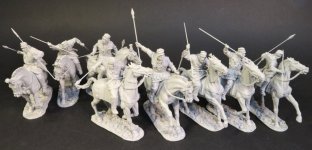
The Achaemenid Empire c. 550–330 BC, also called the First Persian Empire, was an ancient Iranian empire based in Western Asia founded by Cyrus the Great. Ranging at its greatest extent from the Balkans in the west to the Indus Valley in the east, it was larger than any previous empire in history, spanning 5.5 (or 8) million square kilometers. Incorporating various peoples of different origins and faiths, it is notable for its successful model of a centralised, bureaucratic administration (through satraps under the King of Kings), for building infrastructure such as road systems and a postal system, the use of an official language across its territories, and the development of civil services and a large professional army. The empire's successes inspired similar systems in later empires
In the 6th and early part of the 5th century BC Persian horsemen were heavily influenced by the Scythians, were armed with bows and javelins, and fought as light cavalry.
In the second half of the 5th Century there was an increase in armoured cavalry, armed with spears (palta) for thrusting and throwing, and the virtual disappearance of cavalry archers. The change and development can be directly linked to the wars against the Greek armies in the west.
These horsemen usually carried two palta, made from cornel wood. One could be thrown, and the other used for thrusting. The cornel wood spears were also stronger than the Greek spears, and Xenophon describes an encounter between Greek and Persian cavalry in 396BC when the Persians fought successfully with their palta, while the Greek spears broke too easily.
Later developments were to occur, when the Persians faced Alexander the Great’s Macedonian cavalry. The long Macedonian thrusting spear (also made from Cornel wood) had a big advantage over the shorter Persian thrusting spear which is one of the reasons for the Macedonian success at the Graneikos.
Darius III in the preparations for Gaugamela, tried to equip more of his cavalry with longer spears, or Macedonian style lances and adopt much heavier armour, including partial armour for the horses.
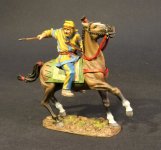
APCAV-06A
ARMIES AND ENEMIES OF ANCIENT GREECE
AND MACEDONIA,
THE ACHAEMENID PERSIAN EMPIRE,
PERSIAN CAVALRY
(4 pcs)
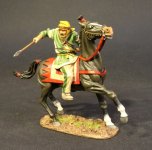
APCAV-06B
ARMIES AND ENEMIES OF ANCIENT GREECE
AND MACEDONIA,
THE ACHAEMENID PERSIAN EMPIRE,
PERSIAN CAVALRY
(4 pcs)
**FOR FURTHER INFORMATION PLEASE CONTACT YOUR LOCAL DEALER**
THE ANCIENTS COLLECTION
ARMIES AND ENEMIES OF ANCIENT GREECE AND MACEDONIA
THE PELOPONNESIAN WAR (431-404BC)
THE SPARTAN ARMY
The Peloponnesian War (431–404 BC) was an ancient Greek war fought by the Delian League led by Athens against the Peloponnesian League led by Sparta. Historians have traditionally divided the war into three phases. In the first phase, the Archidamian War, Sparta launched repeated invasions of Attica, while Athens took advantage of its naval supremacy to raid the coast of the Peloponnese and attempt to suppress signs of unrest in its empire. This period of the war was concluded in 421 BC, with the signing of the Peace of Nicias. That treaty, however, was soon undermined by renewed fighting in the Peloponnese. In 415 BC, Athens dispatched a massive expeditionary force to attack Syracuse, Sicily; the attack failed disastrously, with the destruction of the entire force in 413 BC. This ushered in the final phase of the war, generally referred to either as the Decelean War, or the Ionian War. In this phase, Sparta, now receiving support from the Achaemenid Empire, supported rebellions in Athens's subject states in the Aegean Sea and Ionia, undermining Athens's empire, and, eventually, depriving the city of naval supremacy. The destruction of Athens's fleet in the Battle of Aegospotami effectively ended the war, and Athens surrendered in the following year. Corinth and Thebes demanded that Athens should be destroyed and all its citizens should be enslaved, but Sparta refused.

The Peloponnesian War reshaped the ancient Greek world. On the level of international relations, Athens, the strongest city-state in Greece prior to the war's beginning, was reduced to a state of near-complete subjection, while Sparta became established as the leading power of Greece. The economic costs of the war were felt all across Greece; poverty became widespread in the Peloponnese, while Athens found itself completely devastated, and never regained its pre-war prosperity.
Ancient Greek warfare, meanwhile, originally a limited and formalized form of conflict, was transformed into an all-out struggle between city-states, complete with atrocities on a large scale. Shattering religious and cultural taboos, devastating vast swathes of countryside, and destroying whole cities, the Peloponnesian War marked the dramatic end to the fifth century BC and the golden age of Greece.
The city of Sparta was just one of the cities located in the ancient Greek state called Lakedaimon. Most of the other cities of Lakedaimon by this time had become subjects of Sparta.
Around the middle of the 5th Century BC the Lakedaimonians started to lighten the equipment of their holpites. The traditional greaves and cuirass were discarded, and the closed Corinthian helmet was replaced by the open-faced “Pilos Helmet”.
A crimson short sleeved tunic, the “exomis” was commonly worn, with the right shoulder unpinned and allowed to fall leaving the right arm and shoulder free for action. In the 4th Century the army of Agesilaos was clad entirely in Crimson. This had become the colour of the soldier and especially of the Lakedaimonian soldier. Apparently the Lakedaimonian soldier was even buried in his crimson robe.
During this period the Lakedaimonians were allowed to grow their hair and beard when on campaign, a style which had fallen out of fashion elsewhere in Greece at this time.

SPT-02
ARMIES AND ENEMIES OF ANCIENT GREECE
AND MACEDONIA,
THE PELOPONNESIAN WAR 431-404BC,
THE SPARTAN ARMY,
SPARTAN PIPER.
(1 pc)
Sparta was pretty much like every other Greek state. They had music, art and poetry. During the seventh century, a musician named Terpander came to Sparta and established himself there. He is called the “father of Greek music”. The most widely known Spartan musician was Tyrtaeus. He lived during the Second Messenian War and it was said his music inspired many Spartan soldiers to new heights of bravery.
THE ACHAEMENID PERSIAN EMPIRE 550-330BC

The Achaemenid Empire c. 550–330 BC, also called the First Persian Empire, was an ancient Iranian empire based in Western Asia founded by Cyrus the Great. Ranging at its greatest extent from the Balkans in the west to the Indus Valley in the east, it was larger than any previous empire in history, spanning 5.5 (or 8) million square kilometers. Incorporating various peoples of different origins and faiths, it is notable for its successful model of a centralised, bureaucratic administration (through satraps under the King of Kings), for building infrastructure such as road systems and a postal system, the use of an official language across its territories, and the development of civil services and a large professional army. The empire's successes inspired similar systems in later empires
In the 6th and early part of the 5th century BC Persian horsemen were heavily influenced by the Scythians, were armed with bows and javelins, and fought as light cavalry.
In the second half of the 5th Century there was an increase in armoured cavalry, armed with spears (palta) for thrusting and throwing, and the virtual disappearance of cavalry archers. The change and development can be directly linked to the wars against the Greek armies in the west.
These horsemen usually carried two palta, made from cornel wood. One could be thrown, and the other used for thrusting. The cornel wood spears were also stronger than the Greek spears, and Xenophon describes an encounter between Greek and Persian cavalry in 396BC when the Persians fought successfully with their palta, while the Greek spears broke too easily.
Later developments were to occur, when the Persians faced Alexander the Great’s Macedonian cavalry. The long Macedonian thrusting spear (also made from Cornel wood) had a big advantage over the shorter Persian thrusting spear which is one of the reasons for the Macedonian success at the Graneikos.
Darius III in the preparations for Gaugamela, tried to equip more of his cavalry with longer spears, or Macedonian style lances and adopt much heavier armour, including partial armour for the horses.

APCAV-06A
ARMIES AND ENEMIES OF ANCIENT GREECE
AND MACEDONIA,
THE ACHAEMENID PERSIAN EMPIRE,
PERSIAN CAVALRY
(4 pcs)

APCAV-06B
ARMIES AND ENEMIES OF ANCIENT GREECE
AND MACEDONIA,
THE ACHAEMENID PERSIAN EMPIRE,
PERSIAN CAVALRY
(4 pcs)
**FOR FURTHER INFORMATION PLEASE CONTACT YOUR LOCAL DEALER**

